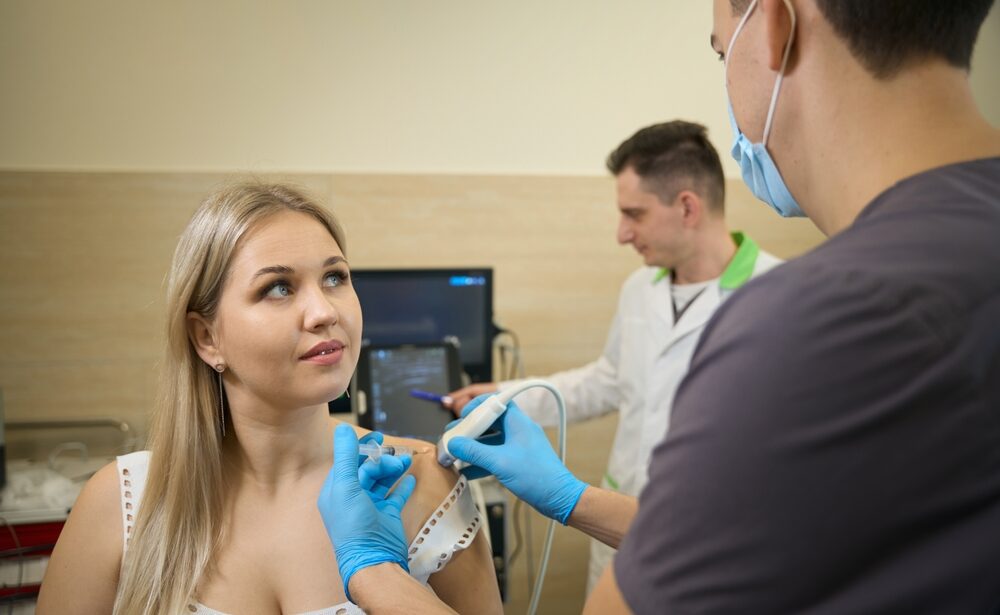Overview
Ultrasound-guided joint and soft tissue injections are minimally invasive procedures that utilize real-time ultrasound imaging to accurately guide the placement of therapeutic agents, such as corticosteroids, hyaluronic acid, or anesthetics, into specific joints or soft tissues. This technique enhances the precision of injections, improving efficacy and reducing the risk of complications. It is commonly used to treat conditions such as arthritis, bursitis, tendonitis, and other musculoskeletal disorders.
Indications for Ultrasound-Guided Injections
Ultrasound-guided injections are indicated for various conditions, including:
- Arthritis: Both osteoarthritis and inflammatory arthritis (e.g., rheumatoid arthritis).
- Tendon Injuries: Tendonitis or partial tears affecting tendons, such as the rotator cuff or Achilles tendon.
- Bursitis: Inflammation of bursae, which are fluid-filled sacs that cushion joints.
- Soft Tissue Masses: Injection of therapeutic agents into cysts or nodules.
- Nerve Entrapment Syndromes: Targeted injections for conditions like carpal tunnel syndrome.
Pre-Injection Assessment
- Clinical Evaluation:
- A healthcare provider performs a thorough assessment of the patient’s medical history and physical examination to identify the target joint or soft tissue area for injection.
- Ultrasound Imaging:
- The area of interest is examined using ultrasound to assess anatomy and identify any abnormalities, helping to visualize the best approach for injection.
Ultrasound-Guided Injection Procedure
- Preparation:
- The patient is informed about the procedure, including the benefits, risks, and expected outcomes. Consent is obtained.
- The skin over the injection site is cleaned and sterilized to reduce the risk of infection.
- Positioning:
- The patient is positioned comfortably to allow optimal access to the target joint or soft tissue area.
- Ultrasound Guidance:
- A qualified healthcare provider uses a handheld ultrasound transducer to visualize the target area in real-time.
- A thin needle is introduced under ultrasound guidance, allowing for precise placement of the injection while avoiding surrounding structures.
- Injection:
- The therapeutic agent (e.g., corticosteroid, hyaluronic acid) is injected into the targeted area.
- The provider may assess the spread of the injection using ultrasound to ensure proper delivery.
- Post-Injection Monitoring:
- The patient is monitored for a brief period after the injection to observe for any immediate reactions or side effects.
Potential Benefits of Ultrasound-Guided Injections
- Increased Accuracy: Real-time imaging allows for precise targeting of the injection site, improving the effectiveness of treatment.
- Reduced Risk of Complications: Enhanced visualization minimizes the risk of injury to surrounding structures such as nerves and blood vessels.
- Faster Recovery: Patients may experience quicker symptom relief and a shorter recovery time compared to other treatment modalities.
- Minimally Invasive: The procedure is performed on an outpatient basis with minimal discomfort, allowing patients to resume normal activities shortly after.
Possible Risks and Side Effects
- Infection: As with any injection, there is a small risk of infection at the injection site.
- Bleeding or Bruising: Minor bleeding or bruising may occur at the injection site.
- Temporary Pain or Discomfort: Some patients may experience transient pain or discomfort after the injection.
- Allergic Reactions: Rarely, patients may have allergic reactions to the injected substances.
Final Results
With the administration of ultrasound-guided joint and soft tissue injections, patients can expect:
- Symptomatic Relief: Effective reduction of pain and inflammation in targeted areas, leading to improved mobility and function.
- Enhanced Quality of Life: Many patients experience significant improvements in their daily activities and overall quality of life following treatment.
- Personalized Treatment Plans: The procedure can be tailored to individual patient needs, including the type of agent used and the frequency of injections.

